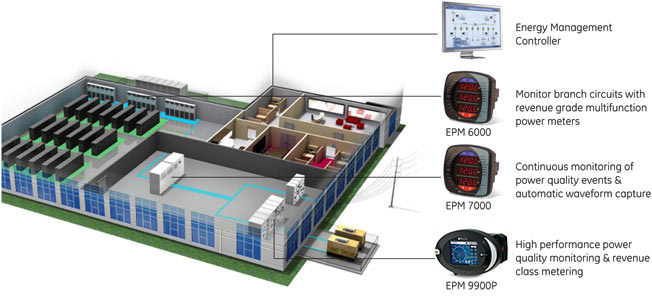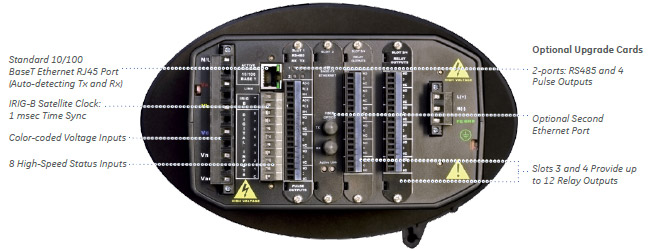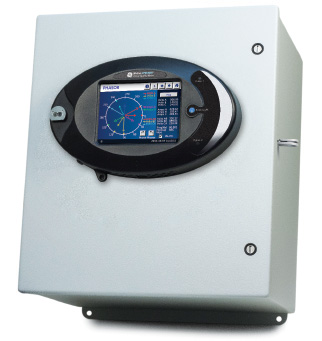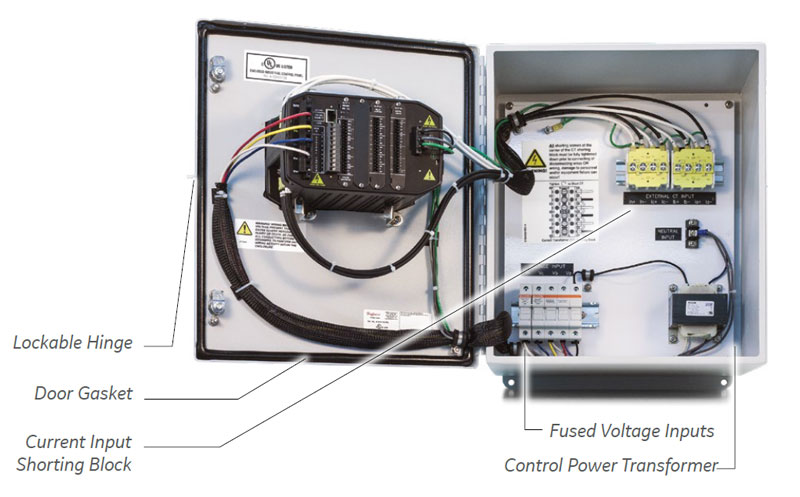Features
Communications
- Modbus, DNP 3.0, IEC 61850 (including high speed GOOSE messaging), SNMP, IEC 1588 PTPv2 and IEEE 37.118.2-2011
- Standard Ethernet communications port with dual Ethernet capability
- Port control to secure and disable services/ports
- Easy system integration supporting up to 32 Modbus TCP/IP sockets per Ethernet port along with configurable Ethernet port services for security
Measuring and Metering
- 0.06% Energy Accuracy (ANSI 0.2%)
- IEC 61000-4-30 Power Quality Class A Ed. 3 and EN50160 Reporting Support
- Available 50MHz Transient Recorder (over 800,000 samples/cycle)
- Phasor Measurement Unit (PMU) Capability
- Harmonics up to the 511th order (Voltage,Current), 127th order in real time
- Voltage Sag/Swell, Current Fault and Transient Recording
- Up to 4 GB data logging
High Performance Power Quality and Transient Meter for Utility or Industrial Applications

The EPM 9900P provides revenue accuracy for energy monitoring and high performance power quality analysis functions including harmonics, flicker and transient waveform capture. Power quality reporting data is collected in compliance with IEC 61000-4-30 Class A and EN 50160 international standards providing users a deep understanding in a variety of utility or industrial applications.
With up to 4GB of data logging, including 50 MHz transient capture, the EPM 9900P ensures that essential power quality data and events are captured, stored, and time synchronized allowing for comprehensive analysis of events. The EPM 9900P also supports a multitude of communications protocols such as Modbus, DNP3 and 61850 making it easy to integrate and retrieve data into a SCADA or data analysis system.
Application Example
Multifunction Metering & Power Quality Monitoring
The EPM 9900P can provide a total picture of power usage and power quality at different points within a power distribution network, allowing users to make power related decisions quickly and effectively.

Class A Power Quality Reporting

Extensive harmonics analysis capabilities

Comprehensive Phasor visualization

User-friendly reports illustrating PQ compliance


Record and Analyze Waveform Fault and Transient Data
The EPM 9900P captures and stores comprehensive power quality information, including harmonics, sags, swells and transients providing a clear perspective and log of faults and disturbances to allow for detailed and extensive forensic engineering analysis.
IEC 61000-4-30 Class A Ed.3 Power Quality Meter
- Designed specifically to meet the rigorous IEC 61000-4-30 Class A Ed. 3 standard, the EPM 9900P measures and analyzes power quality metrics precisely.
- All reporting is available via the EN 50160 reporting format which can be further customized to meet the required application or regulatory needs.
IEC 61000-4-15 Class A Flicker Meter
- Flicker compliant with the IEC 61000-4-15 Class A standard
- Operates on both 220 volt/50 Hz and 120 volt/60 Hz throughout standard test points
IEC 61000-4-7 Class A Harmonics and Interharmonics Analysis
- View harmonic magnitudes to the 511th order for each voltage and current channel
- Harmonic magnitudes and phase angles in real time are resolved to the 127th order
- Obtain %THD, TDD, and K-Factor
- Conduct power quality analysis at the high end of the harmonic magnitude spectrum
Phasor Analysis
The monitor reads a phase angle analysis between the voltage and current channels, allowing you to analyze efficiency and system integrity.
High-speed Voltage Reliability Measurements
The EPM 9900P meter provides industry leading voltage measurement.
- Real time single cycle RMS measurements
- Customizable high-speed readings – can be set from 2 to 20 cycles RMS
Set Limit Control
Programmable setpoints allowing a user to configure the meter to be used as a control device for many applications, such as:
- Capacitor control
- Load shedding
- Automatic transfer schemes
- Transformer monitoring & control
- Redundant protection (not designed for primary over-current protection)
- Many other control functions
Alarm Notification
The EPM 9900P meter lets you set multiple programmable limits for any measured value, as well as those set up in a Boolean logic tree, and limits set up in the IEC 61850 protocol implementation. Users can be notified of alarm conditions via email.
16 Bit Waveform and Fault Recorder
- Record up to 1024 samples per cycle; capture a transient at over 800,000 samples per cycle or at 50 MHz sampling speed
- Voltage and current recording with pre and post-event analysis
- Fault recording offers 8 times full scale capture capability
- 16 bit A/D converter provides precise waveform resolution
- Both hardware and software triggers are available
High-speed Status Input Triggers
- Waveforms are recorded at time of status change
- Input change and waveform recording are time-stamped to a 100 micro second resolution
- Inputs and waveforms can be displayed together to time breakers and relays
Subcycle 50 MHz Transient Recorder (Software Option C)
A user can define log sizes within the meter. Thus the full memory can be allocated specifically to the desired function.
Independent ITIC/CBEMA Log Plotting
- Quickly view total surges, sags, and average duration in the independent ITIC/CBEMA log
- SEMI F47 graphing for power quality compliance in semiconductor industry
Compatible Waveform Formats
Using GE Communicator software, the meter will provide all waveform data via COMTRADE and PQDIF compatible formats. This allows the waveform PQ and fault records to be read by most third-party waveform analysis software programs.
- COMTRADE (common format for transient data exchange) is defined by IEEE Std C37.111
- PQDIF (power quality data interchange format) is defined by IEEE Std 1159.3-2003
Record Phasor Measurement Unit (PMU) Data for Analysis

EPM 9900P PMU/Synchophasor Functionality
The EPM 9900P meter has been enhanced with Phasor Measurement Unit (PMU) functionality meeting the IEEE C37.118.1a-2014 standard. A PMU device measures time-synchronized, phasor (magnitude and phase angle of voltage and current) and related data from a specific location on the electrical grid. The data from multiple PMUs are transmitted to a phasor data concentrator (PDC), which aggregates and time-aligns the data for real time and post analysis.
Collection of Synchrophasor data is useful in applications such as:
- Aggregation of instantaneous, time synchronized voltage, current, and frequency at specific locations on the grid for easy greater wide-area system operator situational awareness
- Determination of stress points of the utility transmission system
- Detect and aid in restoration an islanded section of the grid after a storm or major outage disturbance
- Collection and integration of PMU data for visualization in an Energy Management System (EMS).
EPM 9900P Synchrophasor Features
- Supports both P and M classes
- Time sync standard: IRIG-B or IEEE 1588 PTPv2
- Calculates individual voltage/current phasors, symmetrical components’ phasors, frequency, rate of change of frequency, the meter’s high-speed digital inputs, analog fundamental power, and displacement power factor
- Data frame rates:
- 50 Hz - 10/25/50 frames per second
- 60 Hz - 10/12/15/20/30/60 frames per second
- Data format: configurable float or integer, polar or rectangular
- Support for up to two simultaneous clients with Ethernet or Fiber over Ethernet communication
Easy System Integration and Available IEC 61850 Solution

Software options B and above offer an embedded IEC 61850 Protocol Server for seamless integration with substation automation and industrial 61850 applications.
- The IEC 61850 Protocol Server allows up to 6 simultaneous MMS clients.
- Either Ethernet port can be configured for IEC 61850 (only one port at a time can run IEC 61850)
- GOOSE publisher/subscriber functionality is supported.
- Buffered and unbuffered reports are supported for the following triggers: general meter interrogation, for example, the report is generated in response to a query; meter integrity, for example, the report is generated according to a programmed interval; and data change, for example, the report is generated due to a change in the contents of a dataset.
- File transfer is supported
- Embedded Web Protocol Server support is available for IEC 61850 CID file uploading, IEC 61850 Protocol Server status and for displaying incoming and outgoing GOOSE messages.
- Multiple Logical Nodes, which map flicker, harmonics, digital inputs/outputs, limit state, voltage, current, energy and other data, are supported.
- Waveform capture can be triggered by status input data inside GOOSE messages. The user can program up to 16 status inputs that will trigger a waveform capture when the information is received via a GOOSE message. The status inputs include digital inputs, limit states, and any other status input supported by the meter.
Unique GOOSE Cross Trigger
- Fault-based cross trigger of waveform based on GOOSE message
- Provides system-wide distribution fault analysis on an event
- Timing better than 200 microseconds is typical
- Many different circuits can be viewed after an event occurred

Flexible Communications Options
The EPM 9900P meter offers up to 6 simultaneous communication ports and multiple protocols to meet almost every need.
Hardware Features:
- 2 optional RS485 ports speaking Modbus and/or DNP 3.0
- USB front panel port
- ANSI optical front panel port
- 2 separately addressable Ethernet ports
- Optional Fiber or RJ45 media on one Ethernet port
Ethernet Communication Port Capabilities
- 2 Ethernet ports provide multiple simultaneous communication
- Each port has separate MAC address and IP address
- Supports Modbus TCP/IP, DNP 3.0 and IEC 61850
- GOOSE messaging protocol supported for IEC 61850
- Up to 32 Modbus TCP/IP sockets per Ethernet port
- Highly secure port control to disable unneeded services and ports
- Email Function - SMTP email to client on alarm
- Precise Time Synchcronization - SNTP Time Sync protocol
- File Transfer Protocol - High-speed file data transfer
- Support for IEEE 1588 PTPv2 for critical time sync applications, e.g., synchrophasor systems.
- IEEE C37.118.2 PMU communication
Industry-Leading DNP 3.0 Level 2 Plus – Complies with DNP Level 1 and Level 2 Certification Requirements
- Up to 136 measurements (64 Binary Inputs, 8 Binary Counters, 64 Analog Inputs) can be mapped to DNP static points
- Up to 16 relays and 8 resets can be controlled through DNP
- Report-by-exception processing (DNP Events) deadbands with unsolicited response for serial communication
- 250 available events, in four event types (Binary Input Change, Frozen Counter, Counter Change, and Analog Change)
SNMP Protocol
SNMP protocol V1 and V2 are supported for managed device networks (i.e. Data center network applications) Features include:
- Support for 40+measurements
- Traps for limits, input change, and power quality
- Cold start trap and authentication failure supported
8 Built-in Digital High-speed Status Inputs
- Inputs automatically sense whether the circuit is externally wetted
- If externally wetted, input up to 150 VDC is accepted
- If internally wetted, the meter supplies the necessary voltage for the control application
VAUX Input
- Neutral to ground or aux voltage readings
- Synchronizing schemes, for example, obtaining the frequency, magnitude, and phase angle on both sides of a switch or between generator and bus voltage


Multilin Meter Enclosure
Expanding existing switchgear or installing new metering capability can be challenging due to space limitations, downtime and installation and equipment costs. GE’s Multilin Meter Enclosure is a pre-wired configured, economical solution for both retrofit expansions and small scale meter installations that allows the expansion of existing switchgear capability without expensive and time-consuming design.
When ordered as a meter option the enclosure provides a factory pre-wired, installation-ready metering solution that further drives energy cost savings, by enabling the measurement of key energy usage information along multiple metering points for new or existing systems. Ordering the enclosure is simple when selected as an option during meter configuration, ensuring correct pre-wired meter-compatible delivery.
Pre-Wired, Configured and Economical Solution for Retrofit and Small Metering Systems
Easy and Rapid Installation
- Factory pre-wired, installation-ready GE metering solution eliminates wiring and associated errors for rapid installation
- Extend metering capability with new systems and existing switchgear without system installation downtime
Cost-Effective Retrofit Solution
- Save up to 200% versus the addition of a new switchgear cabinet
- Compact footprint makes effective use of existing allocated space
- Allows new installations or the expansion of existing switchgear capability without expensive, time-consuming designs, eliminating system downtime
Reliable and Compatible
- Backed by a 10 year warranty
- Simple meter option ordering ensures compatibility with GE EPM 9900P meters
- Comprehensive factory testing of both meter and enclosure together
- NEMA1 tested and UL/CUL certified
Applications (New and Retrofit installations)
- Utility/Indusrial Power Quality Studies
- Healthcare Institutions
- Government Buildings
- Manufacturing
- Educational Campuses
- Data Centers
Meter Enclosure Assembly
The installation of the GE’s Multilin Meter Enclosure is simple, safe and eliminates downtime through simple mounting and wiring. The enclosure is UL/CUL certified and NEMA 1 rated making it ideal for indoor environments.
It is provided in two voltage configurations (120-240V and 277V) to ensure compatibility with customer installations. The standard equipment includes voltage fuses; a shorting block for current transformers; and a control power transformer for 277V power systems that are pre-wired and configured to ensure safety, quality and long-term reliability.

Software Options
The EPM 9900P provides software options to meet specific power quality measurement functionality as well as logging, sampling and communications requirements.
The software options are also upgradeable after purchase/installation. This provides flexibility to expand functionality for future requirements or budgetary approval.
| FEATURE |
A |
B |
C |
D |
E |
F |
| Basic Measurements |
• |
• |
• |
• |
• |
• |
| Memory |
512 MB |
1GB |
4GB |
512 MB |
1GB |
4GB |
| Sampling Speed (samples/cycle) |
512 |
1024 |
1024 |
512 |
1024 |
1024 |
| 50 MHz Transients |
|
|
• |
|
|
• |
| IEC 61000-4-30 Class A Edition 3 |
• |
• |
• |
• |
• |
• |
| IEC 61850 Server |
|
• |
• |
|
• |
• |
| IEC 61850 GOOSE |
|
• |
• |
|
• |
• |
| CyberSecurity |
|
|
|
• |
• |
• |
| Synchrophasor PMU |
|
|
|
• |
• |
• |
Technical Specifications
| INPUT VOLTAGE RANGE |
- (5-347)VAC, Line to Neutral
- (10-600)VAC, Line to Line
|
| VOLTAGE INPUT WITHSTAND CAPABILITY |
- Voltage Inputs isolated to 2500VAC
|
| INPUT CURRENT RANGE |
- Programmable to any CT radio
- Class 2: Nominal 1 A, with 2 times over range
- Class 2: fault current recording to +/- 16 A peak
- Class 20: Nominal 5 A, with 4 times over range
- Class 20: fault current recording to +/- 80 A peak
|
| CURRENT INPUT WITHSTAND CAPABILITY (AT 23 °C) |
- 100 Amps for 10 Seconds
- 300 Amps for 3 Seconds
- 500 Amps for 1 Second
|
| BURDEN |
- Voltage Inputs: 0.072 VA/Phase Max at 600 Volts, 0.003W/Phase Max at 120 Volts
- Current Inputs: 0.008 VA per Phase Max at 20 Amps
|
| ISOLATION |
- All inputs to outputs are isolated to 2500 VAC
|
| TEMPERATURE RATING |
- Operating Temperature: (-20 to +70)°C
- Humidity: Up to 95% RH Non-condensing
- Storage Temperature: (-30 to +80)°C
|
| SENSING METHOD |
- Up to 1024 Samples per Cycle (Programmable)
- 16 Bit A/D Resolution – Multiple Converters
- True RMS
- Constant CalibrationTM technology
- Transients measured at 800,000 samples per cycle
|
| ACCURACY RATING |
- ANSI C12.20 (Class 0.2) and IEC 62053-22 (Class 0.2S) Accuracy, 0.06% Energy measurement accuracy
- Full accuracy specifications available in User Manual
- Time clock: 3.5 ppm for -40 to +85°C - less than 10 seconds drift per month on crystal sync; 2.0 ppm Typical from 0 - +40°C - less than 6 seconds per month drift
|
| UPDATE TIME |
- 1 Second — Revenue Accurate Readings
- 1 Cycle — Faster updated readings
- Customizable high-speed readings from 2 to 20 cycles RMS
|
|
|
| CONTROL POWER REQUIREMENTS |
- HI Option: (100-240)VAC @50/60 Hz or (100-240)VDC
- AC Option: (100-240)VAC @50/60 Hz
- LD Option: (18-60)VDC (24-48 VDC Systems)
- Burden: 25 VA Max
|
| FREQUENCY RANGE |
|
|
| COMMUNICATION FORMAT |
- Programmable parity and stop bits
- Communication Protocols: Modbus TCP/IP, ASCII/RTU, DNP 3.0, IEC 61850 (Software Option B or C)
- ANSI Optical Port
- USB 1.1/2.0 Virtual COM Port
- RJ45 Ethernet Port 10/100BaseT
- Standard RJ45 Ethernet Port 10/100BaseT
- Optional Serial RS485 Ports (Meter, I/O card)
- Optional 2nd Ethernet port - RJ45 Ethernet or Fiber Optic
|
| SHIPPING |
- Total shipping weight: approx. 6.5 lbs (2.9 kgs)
- Shipping container dimensions:
16” x 15.5” x 11.5”
(40.64 am x 39.37 cm x 29.21 cm)
|
| COMPLIANCE |
- ANSI C12.20 (Class 0.2) and IEC 62053-22 (0.2S Class) Accuracy
- ANSI C12.1 (Code for Electricity Metering)
- ANSI C62.14 (Burst)
- FCC Part 15, Subpart B, Class A
- IEC 62053-23 Ed. 1
- IEC 61000-4-2 - ESD
- IEC 61000-4-3 - Radiant Immunity
- IEC 61000-4-4 - Fast Transient
- IEC 61000-4-5 - Surge Immunity
- IEC 61000-4-6 - Conducted Immunity
- IEC 61000-4-7 - Harmonics
- IEC 61000-4-15 - Flicker Meter
- IEC 61000-4-30 - Class A Ed. 3
- IEC 61000-6-2 2005 (Immunity for Industrial Environments)
- IEC 61000-6-4 2006 (Emissions Standards for Industrial Environments)
- IEC 61850 Level A, Ed. 2 Certified
- CISPR11 Ed. 5.1 (Conducted Emissions)
- CISPR22 Class A
- IEC 62052-11 2003- General
Requirements
- CE Marked
- UL and cUL Listed
|
|
Note: Please see product User Manual for comprehensive specifications.













